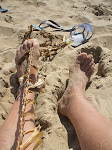This is the title I have given to the piece that I made for the group show
This Beloved Earth which opened yesterday at the
Barony Centre in West Kilbride, Scotland and will remain on show until the 23rd November.
It is in fact 35 baskets made only from materials gathered from the shores and banks on the island of Yell in Shetland, most of it from within fifty metres of the house where I stay. The ropes were washed and some of them separated to make new finer twisted threads for stitching. The stitches that I have used are only those seen on baskets that were made and used in Shetland. The broken buoys and other bits of ceramic and plastic were drilled but otherwise left as they were found. The grasses and oats were just gathered and dried.
 |
| Kirkabister |
The quantity of rope and plastic washed up on the beaches of the islands is astonishing, much of it almost new and obviously jettisoned by commercial fishing boats. A lot of it has travelled many miles in the Atlantic along both the North Atlantic Drift and the Gulf Stream to arrive on the foreshore at the head of Mid Yell Voe and from where there is nowhere further for it to go. There are plastic mussel pegs and ropes (aka droppers) rubber gloves and wellington boots, bicycle helmets, hard hats, blue chemical drums, buoys, floats, netting and the ubiquitous yellow fish crates belonging to LHD. Whole crates tend to find their way back into use, somehow or another, but broken ones just sit there waiting for the Voar Redd Upp when the locals armed with bin bags will gather as much as they can.
 |
| LW and JJIB 2013, Mid Yell Voe |
 |
| Camb |
 |
| Brekkon |
 |
| Camb |
In the past the people of the islands were expert at beach-combing and at making the most of anything that arrived in this haphazard but free way. Shipwrecks were an opportunity to acquire things undreamed of any other way and many houses had roof timbers and furniture that had once been part of a ship. Now people can have anything they want delivered to their homes in the islands and there is little interest in scavenging along the shore. New houses are often built without chimneys so even gathering driftwood is of little interest. There was a time before organised waste collection where any crockery or glass that got broken in the home was just chucked into the Voe and there are plenty of stories of tractors and cars being disposed of in the same way. For me, this jetsam provides a myriad of material choices but apparently most tourists would prefer not to have to look at these things, it is one of the few complaints that visitors make to the Islands tourist board. For the wildlife this jetsam is just dangerous, birds, seals and otters get tangled in nets and ropes and choke on bits of plastic that they mistake for food.

This
sentinelle on a path leading to one of the Atlantic beaches in France visually sums up the long term problem that these things cause.Waste disposal in a consumer economy is fraught with environmental dilemmas but dumping rope and fish crates into the sea is just a lazy solution to a difficult problem.









